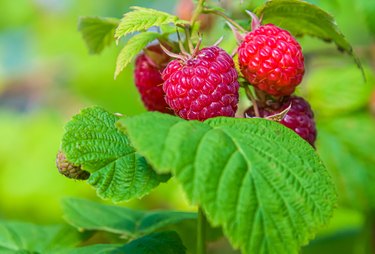
Connecticut is a prolific berry country offering both wild and farm-raised berry vines, shrubs and trees throughout the state. Whether you are interested in the medicinal properties of certain berries, improving your home garden with this list of berry-producing plants, or going on a berry-picking adventure, Connecticut offers many native berry-producing plants to enjoy.
Medicinal Berries in Connecticut
Video of the Day
American history includes a rich culture among native tribal peoples of using wild plants and their parts, including roots, leaves and berries for medicinal uses. Sumac berries (Rhus spp.), hardy in U.S. Department of Agriculture zones 3 to 9, depending on the species, grow on a large leafed shrub type of tree throughout the Northeast, including Connecticut. The Chippewa tribe used the berries to soothe stomach pains. Make a refreshing and tart lemonade-style drink with a handful of fresh-picked sumac berries.
Video of the Day
Edible Plants in CT
Consider planting the American highbush cranberry tree in your Connecticut yard to add beauty, charm and yummy fruit with a plethora of health benefits and antioxidant qualities. The highbush blueberry (Vaccinium corymbosum, zones 3-8) is another nutritional and tasty fruit that grows wild throughout Connecticut.
At least five species of the raspberry grow in forests as wild berries in Connecticut or on farms, including the American red raspberry (Rubus idaeus var. strigosus, zones 4-8) and the black raspberry (Rubus occidentalis, zones 4-8). Plan a fun berry-picking outing to one of the many berry farms throughout Connecticut during the harvest months of July and October.
Poisonous Berries in Connecticut
Controversial as to its safety, the chokecherry tree (Prunus virginiana, zones 2-6) grows profusely throughout Connecticut and the rest of the Northeast. The leaves and seeds of the chokecherry tree are highly poisonous to humans and animals, particularly livestock such as goats, sheep, cattle and horses. The flesh of the berry fruit is considered safe for human consumption and is considered a last resort food by the wild birds that seek the berries in the dead of winter, when more nutritious options have become scarce.
Treat your palate to a glass of chokecherry wine to sample this fruit's finer side. A poisonous variety of sumac (Toxicodendron vernix, zones 3-8) grows in Connecticut, but is easily distinguishable from its palatable cousin by the white berries it produces.
Landscaping Berry Plants
Partridgeberry (Mitchella repens, zones 3-8), bearberry (Arctostaphylos uva-ursi, zones 3-7) and juniper (Juniperus spp., zones 3-9, depending on the species) are berry-studded evergreen shrubs ideal for maintaining greenery in your yard during the drab winter months. Partridgeberry is especially suited for shady areas. Attract wild birds to your yard with the cheerful bearberry shrub. The bright red berries are a favorite of ground-dwelling birds.
Juniper is arguably one of the hardiest lawn ornaments on the planet with a variety of types to choose from. Let your inner artist out and try trimming your juniper bush into an interesting shape or form. Before the days of landscaping took shape in America, native people used the juniper berries in poultices to ease aches and pains.